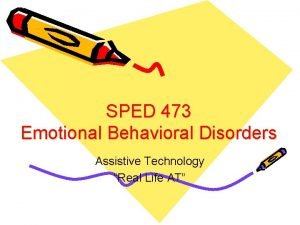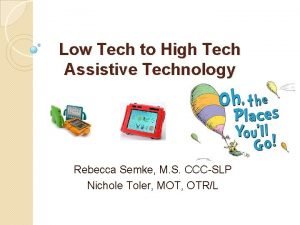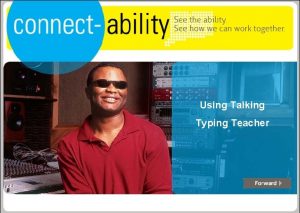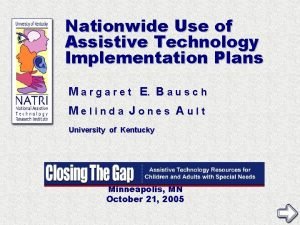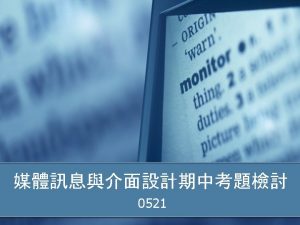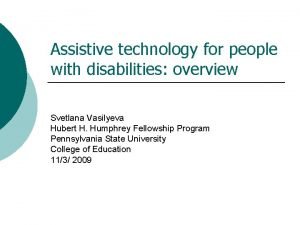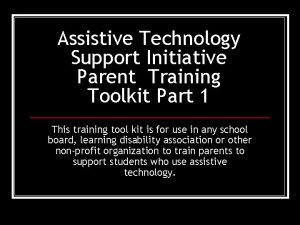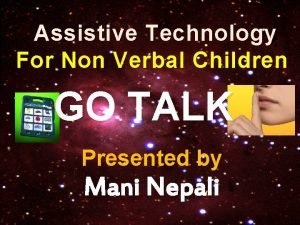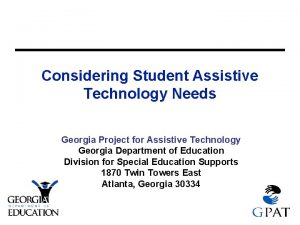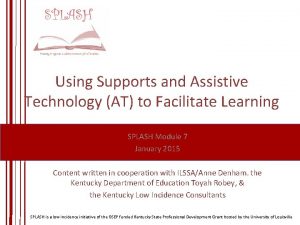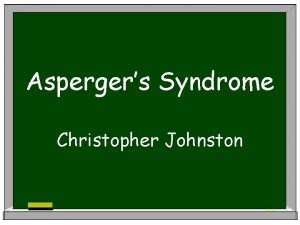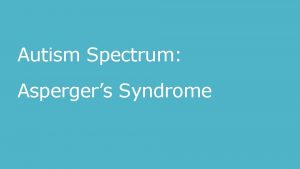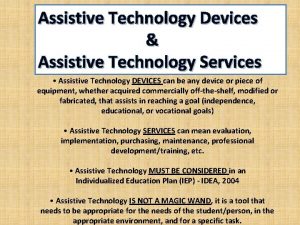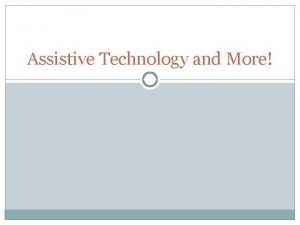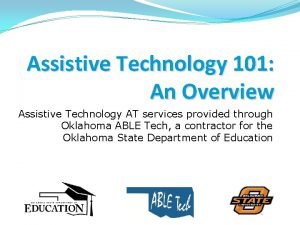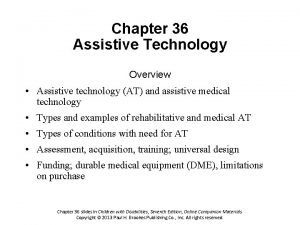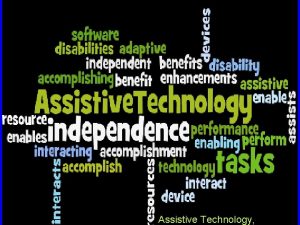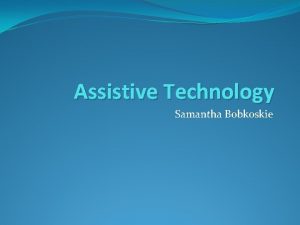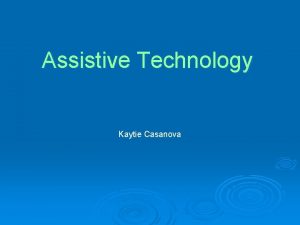Aspergers Syndrome and Assistive Technology Introduction n This













- Slides: 13

+ Asperger’s Syndrome and Assistive Technology

+ Introduction n This study was done on children with Autism Spectrum Conditions (ASC). Children with ASC have impairments in social communication, meaning they have difficulty recognizing emotions in themselves and other. n The study explored the use of assistive technology to teach emotion recognition (ER) to eight children with ASC. Participants were between the ages of 8 and 11 years and had a diagnosis of Asperger syndrome (AS). ER testing was conducted using a computer at pre- and postintervention. The intervention consisted of 10 weeks of using the computer software Mind Reading: The Interactive Guide to Emotions[sup. TM] in either home or school settings.

+ Introduction Cont’d n A relatively new multimedia computer program used to address ER is Mind Reading: The Interactive Guide to Emotions, an interactive software program designed to teach ER in a systematic and comprehensive format. n Several recent studies have investigated the use of the Mind Reading software and the ability of individuals with ASC to recognize emotions, both with adults and with children. The results showed that after 10 to 15 weeks of using Mind Reading, the adult intervention group improved in the recognition of complex emotion and mental states such as intimate, insincere; from both faces and voices, but there were problems with generalization to other tasks that were not covered in Mind Reading. In the children's study, after 10 to 15 weeks of using Mind Reading in the home setting, the intervention group improved on complex ER from faces and voices and on the ability to generalize this skill to novel emotional voices and pictures of the eye region, suggesting improved generalization compared to adult software users.

+ Methods n Participants: Two girls and six boys, ages 8 through 11, participated in the study. All participants were European American and had a formal diagnosis of AS. n Setting: Preintervention and postintervention assessments were conducted in a staff office located on a campus of a major midwestern university. All participants were tested individually. The intervention took place in either a home (five participants) or a school setting (three participants). Of those who participated in school, two students attended a private school for students with learning disabilities, whereas the third attended a public elementary school. All students used IBM or IBM-compatible computers in their homes or classrooms.

+ Methods Cont’d n Design: The study used a pretest-posttest experimental group design. Before the students began the intervention phase, they completed the ER pretest. After a 10 -week intervention phase, they completed the ER posttest. n Testing: Four different tests were used: CAM-C, C-FAT, FMF-C, and Mind Reading. The CAM-C and C-FAT were administered in random order, and students were allowed to take as many breaks as they needed. The CAM-C face recognition subtest presented items randomly, so only one version was needed. The CAM-C voice recognition subtest and the C-FAT task had two versions; one was used at preintervention and the other at postintervention. The version used at pre- and postintervention was randomized between participants. The RMF-C task had just one version, which was only presented at postintervention to avoid improvement due to familiarity with the scenes.

+ Methods Cont’d n Procedures Cont’d: The Mind Reading computer software was used by each participant during the intervention for at least 10 weeks. Students were directed to use the games zone for no more than 33% of the total time that they were using the software to make sure that lessons and quizzes were taken. During the 10 week intervention, researchers called on the participants in the home setting to (a) check on progress, (b) answer questions, and (c) help solve any problems. A researcher visited the school participants in their classrooms every 2 weeks to conduct the same type of check-in. n After each participant had used the software for 10 weeks, a postintervention assessment was done. The procedure and setting for posttest were identical to those of pre-intervention assessment, except that another test, the RMF-C, was used as well.

+ Results n In conclusion, results show that posttest scores were significantly higher than pretest scores. n Mind Reading is a promising new tool for teaching emotion recognition to children with AS. Children with AS improved their recognition of basic and complex emotions in faces and voices following a time-limited, computer-based intervention. This was found not only on face and voice ER tasks presenting faces and voices included in the software but also on voices that were not included in the software, suggesting that participants could generalize their ER skills.

+ Results n In conclusion, results show that posttest scores were significantly higher than pretest scores. n Mind Reading is a promising new tool for teaching emotion recognition to children with AS. Children with AS improved their recognition of basic and complex emotions in faces and voices following a time-limited, computer-based intervention. This was found not only on face and voice ER tasks presenting faces and voices included in the software but also on voices that were not included in the software, suggesting that participants could generalize their ER skills.

+ Results n In conclusion, results show that posttest scores were significantly higher than pretest scores. n Mind Reading is a promising new tool for teaching emotion recognition to children with AS. Children with AS improved their recognition of basic and complex emotions in faces and voices following a time-limited, computer-based intervention. This was found not only on face and voice ER tasks presenting faces and voices included in the software but also on voices that were not included in the software, suggesting that participants could generalize their ER skills.

+ Limitations n The limitations of this study include the use of a small sample size and the exclusion of an ASC or a typically developing control group. There were only eight participants, which required the use of nonparametric tests, limiting the power of the study. Ultimately the results have to be considered with caution, as other reasons for the increases in student mean scores are conceivable, including the effects of pretesting, maturation, or statistical regression to the mean.

+ Future Research n Other areas of interest include studying how teachers can assist students who use the program and how students with more cognitive challenges can successfully use high-tech applications such as Mind Reading. n Since generalization in only one task was found, more research is needed to study the generalization of these skills to natural settings and to explore if the use of this software helps other social skills. Finally, continued rigorous group interventions are needed to investigate Mind Reading with other populations, larger sample sizes, and control groups.

+ References n American Psychiatric Association. (1994). Diagnostic and statistical manual of mental disorders (4 th ed. ). Washington, DC: Author. n Baron-Cohen, S. (1989). The autistic child's theory of mind: A case of specific developmental delay. Journal of Child Psychology and Psychiatry and Allied Disciplines, 30, 285 -297. n Golan, O. (2006). Systemising emotions: Teaching emotion recognition to people with autism using interactive multimedia. Unpublished doctoral dissertation, University of Cambridge, UK. n Gray, C. A. (2004). Social stories, 10. 0 [Computer software]. Jenison, MI: Jenison Public Schools.

+ Summarized by Marleny Hernandez EME 2040 -Fall 2008
 Assistive technology for carpal tunnel syndrome
Assistive technology for carpal tunnel syndrome Emotional disturbance assistive technology
Emotional disturbance assistive technology High tech low tech
High tech low tech Typing assistive technology
Typing assistive technology Assistive technology implementation plan
Assistive technology implementation plan Assistive technology wikipedia
Assistive technology wikipedia Meaning of assistive technology
Meaning of assistive technology Language tools
Language tools Illinois assistive technology
Illinois assistive technology Don johnson assistive technology
Don johnson assistive technology Go talk assistive technology
Go talk assistive technology Georgia project for assistive technology
Georgia project for assistive technology Assistive technology toys
Assistive technology toys Assistive technology in classrooms
Assistive technology in classrooms

